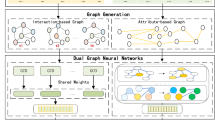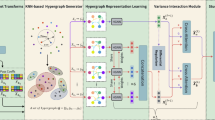Abstract
Academic Abnormality Prediction aims to predict whether students have academic abnormalities through their historical academic scores. However, existing research methods still have the following challenges: (1) Student behavior. Only the students’ historical academic performance is considered, ignoring the impact of student behavior in student status. (2) Data imbalance. The number of academically abnormal students is much less than that of ordinary students, resulting in a data imbalance problem. Therefore, in response to the above challenges, this paper proposes a Multi-level Contrastive Graph learning for academic abnormality prediction (MCG). Specifically, firstly, we capture student behavior and fuse it with student historical achievement data based on a Graph Neural Network (GNN), Thereafter, we construct an embedding space for sample interpolation, which generates virtual nodes of abnormal students, thereby alleviating the data imbalance problem. Moreover, we introduce a multi-level contrastive learning module to precisely learn node representations and maximize the consistency between different views of the same node in the target and online networks for data augmentation. Experiments on real datasets show that the abnormality prediction performance of MCG outperforms the existing state-of-the-art methods.










Similar content being viewed by others
Explore related subjects
Discover the latest articles, news and stories from top researchers in related subjects.Data availability
The datasets generated during and analyzed during the current study are available in the repository, [https://github.com/wyl688/MCG]. We obtained the consent of the dataset authors.
References
Wang S (2014) Analysis of educational data mining to promote personalized learning pathways for college students. Exam Weekly, pp 176
Livieris IE, Kotsilieris T, Tampakas V et al (2019) Improving the evaluation process of students’ performance utilizing a decision support software. Neural Comput Appl 31(6):1683–1694
Nabil A, Seyam M, Abou-Elfetouh Ahmed (2021) Prediction of students’ academic performance based on courses grades using deep neural networks. IEEE Access 9:140731–140746
Xing W, Guo R, Petakovic E et al (2015) Participation-based student final performance prediction model through interpretable Genetic Programming: Integrating learning analytics, educational data mining and theory. Comput Human Behav 47:168–181
Feng G, Fan M, Chen Y (2022) Analysis and prediction of students’ academic performance based on educational data mining. IEEE Access 10:19558–19571
Tao B, Liu K, Miao F et al (2019) Design of Early Warning System for Student’s Poor Academic Performance Based on SVM Improved by KFCM. Research And Exploration In Laboratory 38(5)
Sun Z, Lu C, Shi Z et al (2016) Research and advances on deep learning. Comput Sci 43(2):1–8
Shaoping Jiang (2021) Correlation analysis of student behavior and improvement of GA-BP academic early warning algorithm. Comput Syst Appl 30(4):199–203
Mubarak A, Cao H, Hezam I (2021) Deep analytic model for student dropout prediction in massive open online courses. Comput Electr Eng 93:107271
Zeng Y, Ouyang Y, Gao R et al (2020) Elective future: the influence factor mining of students’ graduation development based on hierarchical attention neural network model with graph. Appl Intell 50(10):3023–3039
Hai-tao P, Ming-qu F, Hong-bin Z et al (2021) Predicting academic performance of students in Chinese-foreign cooperation in running schools with graph convolutional network. Neural Comput Appl 33(2):637–645
Liu M, Shao P, Zhang K (2021) Graph-Based Exercise-and Knowledge-Aware Learning Network for Student Performance Prediction. CAAI International Conference on Artificial Intelligence, pp 27-38
Lu X, Zhu Y, Xu Y et al (2021) Learning from multiple dynamic graphs of student and course interactions for student grade predictions. Neurocomputing 431:23–33
Tan G, Xu F, Qu W (2016) Factors and models influencing students’ behavioral intention to teach online in higher education. e-Education Research, pp 47–53
Chi LP, Xin ZQ (2006) Measurement of college students’ learning motivation and its relationship with self-efficacy. Psychol Dev Edu 22(2):64–70
He XM, Chen XM (2008) A study on the influence of students’ learning engagement on learning interest. Global Edu Outlook 3:46–51
Zhang J, Chen L (2019) Clustering-based undersampling with random over sampling examples and support vector machine for imbalanced classification of breast cancer diagnosis. Comput Assist Surgery 24:62–72
Zhao J, Jin J, Chen S et al (2020) A weighted hybrid ensemble method for classifying imbalanced data. Knowl Based Syst 203:106087
Chen J, Shen Y, Ali R (2018) Credit card fraud detection using sparse autoencoder and generative adversarial network. Electronics and Mobile Communication Conference, pp. 1054–1059
Zaccagnino R, Capo C, Guarino A, et al (2021) Credit card fraud detection using sparse autoencoder and generative adversarial network. Multimedia Tools and Applications, pp. 15803–15824
Guarino A, Lettieri N, Malandrino D, et al (2022) Adam or eve? Automatic users’ gender classification via gestures analysis on touch devices. Neural Computing and Applications, pp. 18473–18495
Clauset A, Shalizi CR, Newman MEJ (2009) Power-law distributions in empirical data. SIAM Rev 51(4):661–703
Milojević S (2010) Power law distributions in information science: making the case for logarithmic binning. J Am Soc Information Sci Technol 61(12):2417–2425
Yang G, Ouyang Y, Ye Z, et al (2022) Social-path embedding-based transformer for graduation development prediction. Applied Intelligence, pp 1-18
Zhao, T, Xiang Z, Wang S (2021) Graphsmote: Imbalanced node classification on graphs with graph neural networks. Proceedings of the 14th ACM international conference on web search and data mining, pp 833–841
Jin M, Zheng Y, Li Y F, et al (2021) Multi-scale contrastive siamese networks for self-supervised graph representation learning. In: proceedings of the thirtieth international joint conference on artificial intelligence, IJCAI-21, pp 1477–1483
Chen X, He K (2021) Exploring simple siamese representation learning. Proceedings of the IEEE/CVF Conference on Computer Vision and Pattern Recognition, pp 15750–15758
Yang Z, Yang J, Rice K et al (2020) Using convolutional neural network to recognize learning images for early warning of at-risk students. IEEE Trans Learn Technol 13(3):617–630
Kong J, Han J, Ding J et al (2020) Analysis of students’ learning and psychological features by contrast frequent patterns mining on academic performance. Neural Comput Appl 32(1):205–211
Kabra RR, Bichkar RS (2011) Performance prediction of engineering students using decision trees. Int J Comput Appl 36(11):8–12
Chang H, Kim H (2021) Predicting the pass probability of secondary school students taking online classes. Comput Edu 164:104–110
Tadayon M, Pottie G (2020) Predicting student performance in an educational game using a hidden markov model. IEEE Trans Edu 63(4):299–304
Prabowo H, Hidayat A, Cenggoro T et al (2021) Aggregating time series and tabular data in deep learning model for university students’ gpa prediction. IEEE Access 9:87370–87377
Jiang Q, Zhao W, Zhao W et al (2017) Empirical research of predictive factors and intervention countermeasures of online learning performance on big data-based learning analytics. e-Edu Res 38(1):62–69
Wu K, Edwards A, Fan W, et al (2014) Classifying imbalanced data streams via dynamic feature group weighting with importance sampling. Proceedings of the 2014 SIAM international conference on data mining, pp 722–730
Chawla NV, Bowyer KW, Hall LO et al (2002) SMOTE: synthetic minority over-sampling technique. J Artif Intell Res 16:321–357
Ling CX, Sheng VS (2008) Cost-sensitive learning and the class imbalance problem. Encyclop Mach Learn 2011:231–235
Zhou ZH, Liu XY (2005) Training cost-sensitive neural networks with methods addressing the class imbalance problem. IEEE Trans Knowl Data Eng 18(1):63–77
He H, Garcia EA (2009) Learning from imbalanced data. IEEE Trans Knowl Data Eng 21(9):1263–1284
LeCun Y, Bottou L, Bengio Y et al (1998) Gradient-based learning applied to document recognition. Proceed IEEE 86(11):2278–2324
Zhou F, Jin L, Dong J (2017) Review of convolutional neural network. Chin J Comput 40(6):1229–1251
Zhang S, Gong Y, Wang J (2019) The development of deep convolution neural network and its applications on computer vision. Chin J Comput 42(3):453–482
Lawrence S, Giles CL, Tsoi AC et al (1997) Face recognition: a convolutional neural-network approach. IEEE Trans Neural Netw 8(1):98–113
Ciresan D C, Meier U, Masci J, et al (2011) Flexible, high performance convolutional neural networks for image classification. Twenty-second international joint conference on artificial intelligence
Xu BB, Sham CT, Huang JJ, Shen HW, Cheng XQ (2020) A survey on graph convolutional neural network. Chin J Comput 43(5):755–780
Lu M, Wang Y, Tan D et al (2021) Student program classification using gated graph attention neural network. IEEE Access 8:87857–87868
Zhang Y, Lu M, Zheng Y, Li HF (2021) Student grade prediction based on graph auto-encoder model. Comput Eng Appl 57(13):251–257
You Y, Chen T, Sui Y et al (2020) Graph contrastive learning with augmentations. Adv Neural Information Process Syst 33:5812–5823
Chen T, Kornblith S, Norouzi M, et al (2020) A simple framework for contrastive learning of visual representations. International conference on machine learning, pp 1597–1607
More A S, Rana D P (2017) Review of random forest classification techniques to resolve data imbalance. 2017 1st International Conference on Intelligent Systems and Information Management (ICISIM), pp 72–78
Da C, Xu S, Ding K, et al (2017) AMVH: Asymmetric multi-valued hashing. Proceedings of the IEEE conference on computer vision and pattern recognition, pp 736–744
Cao Y, Miao QG, Liu JC et al (2013) Advance and prospects of adaboost algorithm. Acta Autom Sin 39(6):745–758
Yang N (2019) Construction of artificial translation grading model based on BP neural network in college students’ translation grading system. J Intell Fuzzy Syst 37(5):6055–6062
Velickovic P, Cucurull G, Casanova A et al (2017) Graph attention networks. Stat 1050:20
Hochreiter S, Schmidhuber J (1997) Long short-term memory. Neural Computat 9(8):1735–1780
Wu J, Wang X, Feng F, et al (2021) Self-supervised graph learning for recommendation. Proceedings of the 44th international ACM SIGIR conference on research and development in information retrieval, pp 726-735
Acknowledgements
This work described in this paper was supported by the National Natural Science Foundation of China (Grant No. 62106070). This work is also support by the Open Foundation of State Key Laboratory for Novel Software Technology at Nanjing University of P.R.China (No.KFKT2021B12) and the Key Research and Development plan of Hubei Province (2020BAB012).
Author information
Authors and Affiliations
Corresponding author
Ethics declarations
Conflict of interest
All authors certify that they have no affiliations with or involvement in any organization or entity with any financial interest or non-financial interest in the subject matter or materials discussed in this manuscript.
Additional information
Publisher's Note
Springer Nature remains neutral with regard to jurisdictional claims in published maps and institutional affiliations.
Rights and permissions
Springer Nature or its licensor (e.g. a society or other partner) holds exclusive rights to this article under a publishing agreement with the author(s) or other rightsholder(s); author self-archiving of the accepted manuscript version of this article is solely governed by the terms of such publishing agreement and applicable law.
About this article
Cite this article
Ouyang, Y., Wang, Y., Gao, R. et al. Multi-level contrastive graph learning for academic abnormality prediction. Neural Comput & Applic 36, 3681–3698 (2024). https://doi.org/10.1007/s00521-023-09268-4
Received:
Accepted:
Published:
Issue Date:
DOI: https://doi.org/10.1007/s00521-023-09268-4




